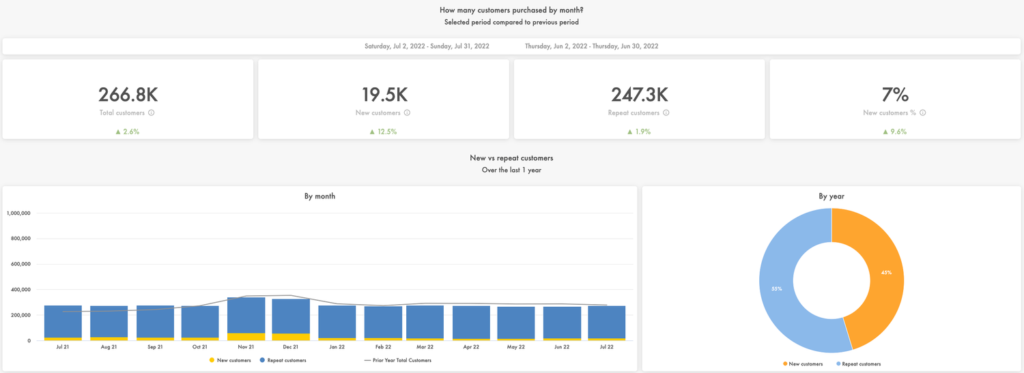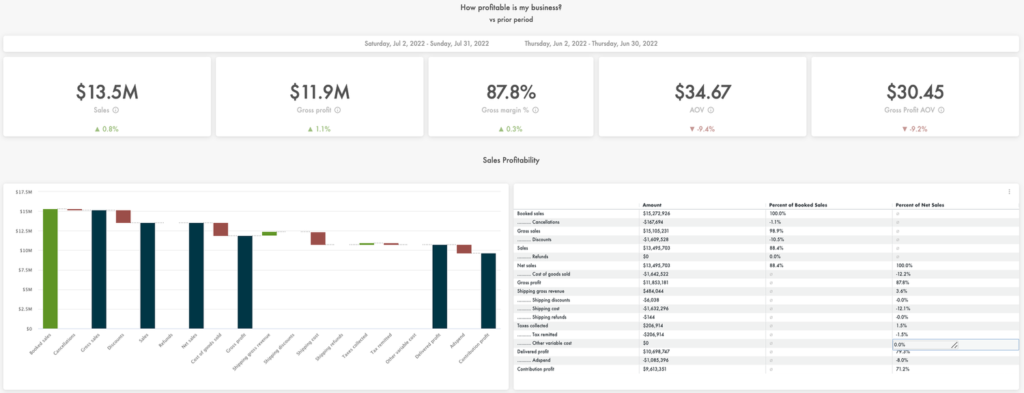Many retailers are looking for better ways to unify their data across all business functions so they can make more informed decisions. If you and your team struggle to answer any of these questions, it’s time to consider a retail data platform.
- Is your company struggling to balance customer expectations with order profitability?
- Is your sales, marketing, and operations data living in disparate systems across your organization with no clear source of truth?
- By the time you collect and analyze all of your data, is it outdated and preventing timely decisions that drive profitable growth?
Retail data platforms unify disparate data systems across an organization and then model the data down to the individual customer and order level to ensure a complete view of exactly what is happening in the business. This unified view allows retail leaders to be confident that every decision made and dollar spent drives profitable growth and increased customer lifetime value. And, the added benefit of a retail data platform is that business users are able to access the data for activation, with no engineering degree required.
1. It’s All in the (Customer) Details
Customers are all unique. They have different shopping habits and purchase different products. Yet, most retailers’ customer data is in so many different systems it’s impossible for them to treat each customer as an individual. Being able to quickly find answers to the following questions will immediately help you to personalize your customer’s shopping experiences, while also ensuring you’re protecting the profitability of each order. You need have answers to the following at your fingertips:
- Who has made repeat purchases but never kept any of their items?
- Who is a serial promotion code user?
- Who is likely to buy online, return in-store, but purchase and keep items from that in-store return visit?
Improved customer shopping experiences will also increase customer loyalty, which will increase the lifetime value of that customer.
Retail data platforms unify marketing, merchandising, and operations data into a complete picture of both shopper engagement and customer experience. Having this view across marketing, customer service, and operations allows you to understand the real cost of discounting and shipping, and most importantly you will have a view of each customer’s lifetime value and profitability.

2. How much did that order really cost? Did we make our monthly numbers?
The costs related to a single order live in multiple places, often without visibility into how much each order actually costs. In addition to the cost of the item(s) purchased, there’s the cost of advertising — social media ads, paid search ads, influencer posts, or direct mail pieces — plus the cost of discounts or promotions, and the cost of free or expedited shipping. Being able to know the profit (or loss) of each transaction will enable you to build segments that inform marketing, promotion, and shipping decisions that will keep each transaction profitable. With so many data points across so many different systems, it can often take weeks or months for each functional team to reconcile their KPIs. This delays the awareness of both risks and opportunities.
By building on granular cost data, retail data platforms provide visibility into the profit of each order, customer, and product. So in real time you can know the profitability of specific campaigns, as well as specific transactions. And since retail data platforms are aware of order and customer KPIs — combining operations and marketing data to determine the ROI can be completed in hours, not weeks.

3. The Solution is Not More of the Same
Even if you’ve built amazing spreadsheet reports and you’ve just hired another in-house analyst, manual reporting wastes time that your teams could be spending on strategic analysis and planning. Additionally, analysis across disparate systems often results in duplication and inaccurate reporting.
Retail data platforms aggregate disparate data into a unified data model for easy access for business users. Teams can focus on insights and action rather than integrations and management.
SoundCommerce is the composable retail data platform that connects and models marketing, operations, and merchandising data so retailers can optimize order and shopper profitability across all business functions. Built for retailers of any size or complexity, SoundCommerce transforms your unique data infrastructure into an easy-to-use, no-code environment that’s accessible to everyone — no engineering degree required. With SoundCommerce, retailers have confidence that every decision and dollar drives profitable growth from the first click to doorstep delivery.
Contact us if you’d like to learn more about how a retail data platform can help your organization to acquire new customers and increase profitability.
Megan Petersen is a Senior Marketing Manager at SoundCommerce. In addition to previous SaaS roles, a majority of her career has been spent in eCommerce and digital experience roles at several retail brands including Theory, Helmut Lang, and Jack Rogers. Outside of work, Megan can be found hiking, skiing, or traveling with her family.

